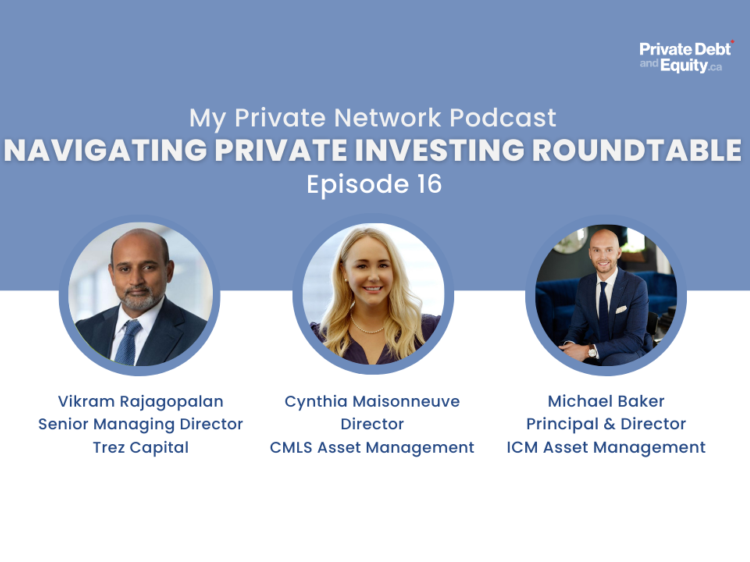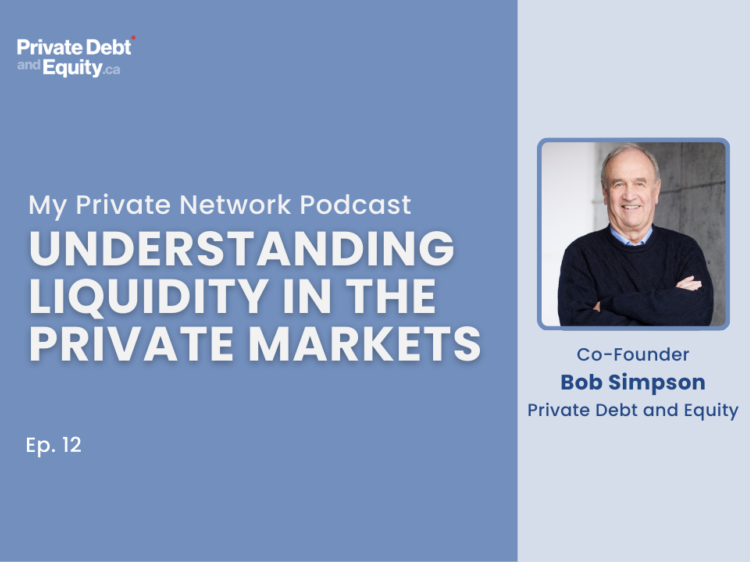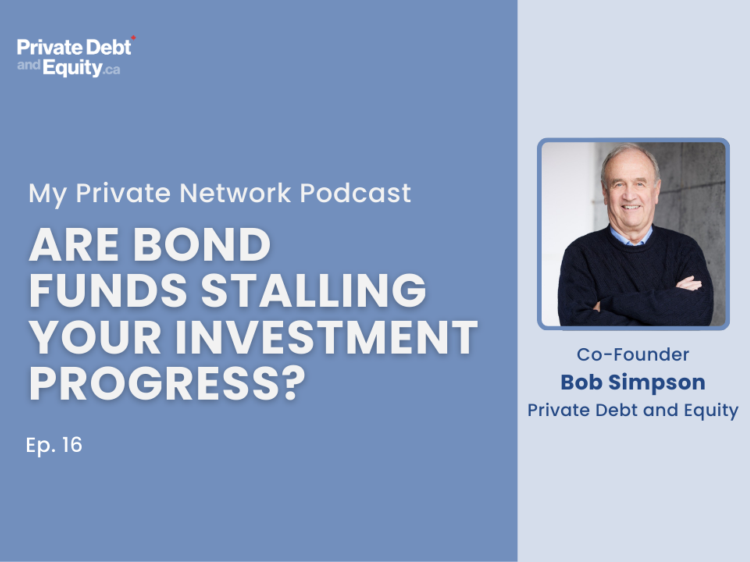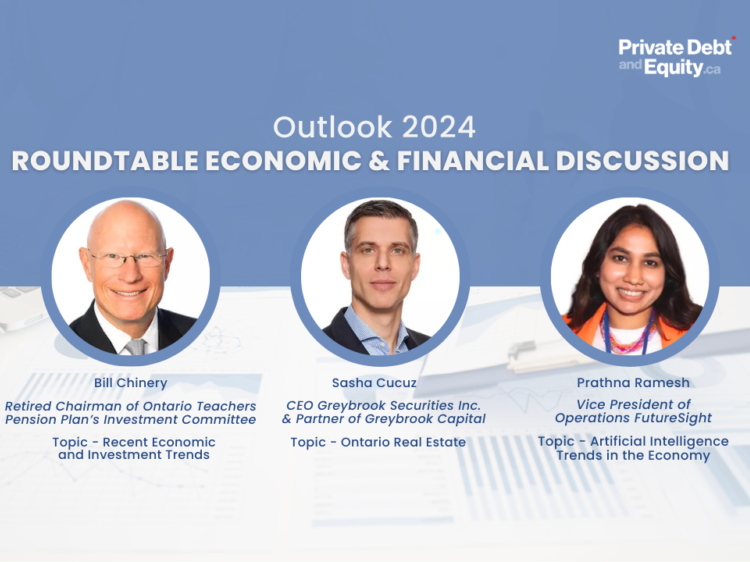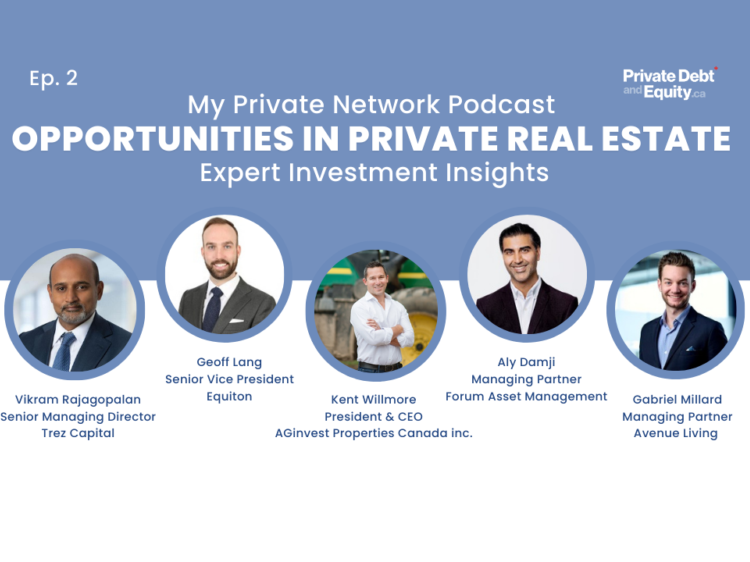Welcome to the My Private Network Podcast!
Interested in learning about private market investing concepts and opportunities available to you?
This week's episode features our co-founder and host, Bob Simpson, who gives you, the investor, a chance to hear from industry experts about why you should consider investing in private real estate debt.
Our expert panelists with "boots on the ground" experience in the private markets
Will Granleese
Director
Antrim Investments
Adam Dean
Vice President & Portfolio Manager
CMLS Financial
Harley Gold
Managing Partner
Peakhill Capital
Today's Questions of Interest
3:30 How does a MIC or Mortgage Investment Corporation operate and what are some benefits to investors?
6:09 Why do you like lending to owners of multi-family apartments? What metrics do you look at when financing a property?
11:29 Given concerns around commercial real estate, what kind of deals are you focused on today and how are you assessing risk differently today than a couple years ago?
Transcript
Bob Simpson: I'm Bob Simpson, your host and Co-Founder of privatedebtandequity.ca, a website to educate investors about concepts and opportunities in private markets. This is our third and final episode focusing on answering the question. "Why allocate assets to private debt?", was episode one. "Why allocate assets to private real estate?", was episode two.
And now, "why allocate assets to private real estate debt?"; things like mortgages or loans that are backed by real estate assets now. I have a question for you, should you lend money to a friend or relative to help them acquire a home? It all comes down to who it is, why you want to do it and do you think that you're ever going to see your money again?
Many have had bad experiences with lending money to friends, associates, and to a single person or for a single property breaking all the investment diversification rules. If something goes wrong, you probably don't have the contacts or the experience. To resolve the issue effectively and emotionally, it can be pretty upsetting.
Now, hiring a professional manager may be the solution on today's panel. We have a series of brief responses from a wide variety of managers focused on private real estate lending. I like to use the phrase. Be the bank instead of lending money to the bank in a deposit account or a GIC, why not lend to borrowers similar to the bank's borrowers?
Now I can, honestly, be pretty bad with analogies, but let's say that you like the idea of having money in a savings account to fund your lifestyle or for emergencies, but you also have a mortgage with the same financial institution. Now, the bank is actually lending your money and paying you three to 4%, sometimes zero if you hold it in a savings account and they lend it right back to you in a floating rate mortgage at six or 7%. Then they're making two to 3% or even more on your money. Leaving you to pay tax on the interest that they are paying you. Today's panel includes professionals in a wide range of activities in the real estate private lending space.
Will Granleese, now his firm specializes in private mortgages lending with well over 2,000 mortgages in his portfolio, Adam Dean primarily with loans to a combination of residential and multi family and Harley Gold, his firm provides competitive and flexible financing structures to developers, investors and REITs.
The doors to my private network are opening. Let's see what we can learn today. Starting out with you, Will. We're going to do a full interview with you in a few weeks, but give us some flavor. How does a MIC, or a Mortgage Investment Corporation, operate? And what are some of the benefits to investors?
Will Granleese: Yeah, thanks very much for the question. Well, a mortgage investment corporation is something similar to a mutual fund. But whereas in a mutual fund you're investing in stocks and bonds. In a mortgage investment corporation you're only investing in mortgages. So what we do is we lend money on first and second mortgages in major centers of Canada and the product provides our shareholders with three main benefits.
The first is stability. So our net asset value never changes. So you don't have the ups and downs of the stock market. Over the past 20 years there's been times where stocks and bonds have both been down by 25 percent and that balanced portfolio doesn't necessarily work. With a mortgage investment corporation, you can have that stability that our clients are looking for.
The other thing is the liquidity. So we do redemptions on a T plus two basis which means you can get your funds back, in two days, which is relatively rare in the mortgage world. But highly regarded by our shareholders.
And lastly, growth. So over the next 12 months, because interest rates are increasing, we're expecting to earn an 8 percent return. So that's an 8 percent return with total stability of your portfolio.
Now, I guess the question comes up, how do we provide this security or where is the security coming from? And that comes from our way of blending, in which case we're only going to land up to 75% of the value of any property. And that is the absolute max that we'll lend.
On average in the portfolio, the average loan is only 58 percent of the average property. So over the past 35 years of our business, we've never had a 12 month period where we've actually lost any funds. And during that time we've managed a rate of return well over 8%. So you've got that security in the portfolio. You've got professional management.
We tend to do about 75 percent of our mortgages in first mortgages and about 25 percent in second mortgages. And we only deal in the residential space. So there's no commercial mortgages that tend to fluctuate as the economy fluctuates. A very, very safe investment. Again, stability, security, and growth are the three points that we're going to be talking.
Bob Simpson: Adam Dean, this is a two part question for you. Number one, why do you like lending to owners of multi-family apartments? Why is that a target audience for you and your business? And what metrics do you really look at when you're financing a property?
Adam Dean: There are several reasons, and the first one that I would touch on is just attractive market fundamentals.
The imbalance between supply of housing for Canadians and the demand. And if we look at population levels, just given that housing is a basic need, population levels are directly correlated with housing demand. And Q3 of 2023 saw another record growth in working age population in Canada. And I say another because that followed record working age population growth.
In both the first and second quarters of this year as well. And there is zero historical precedent for three consecutive record quarters of working age population growth in Canada. So it's nearly impossible for supply of housing to keep up with that growth. And what that does is that creates very supportive conditions for both the income and value of multi residential properties and that's good for a lender on those assets.
The second reason is that we have the opportunity to be part of the solution to improving affordability of housing for Canadians by investing capital in the space. Developers need to feel confident in the liquidity of their properties and the finance ability of their properties and our lending products and again, introducing capital to the multi residential space provides that confidence.
Our firm as a whole has an objective of providing over 20 billion in financing solutions to projects that meet affordability criteria between 2022 and 2026 and are making significant progress towards that objective.
The third reason that I'll touch on is just. The dynamics that regulatory considerations like rent control provide to the space. Now to be clear, rent controls make it very difficult for property owners to pro forma what the income looks like at their assets. So I'm not advocating more broadly for the benefits of rent control, but as a lender, if I'm looking at lending on a multi residential asset, it's very likely that I'm looking at the rents that tenants are paying in that property that are significantly less than what a new tenant would pay in a newly available unit.
And the reason that is, is that if the tenants lived at the property for several years, rents can only be increased a specific amount on an annual basis. So what you end up is properties where the rents that are paid by tenants are significantly less than what they could be achieving if there were new tenants in those units.
And what that does for us as lenders is it creates embedded income upside at the asset level and also downside protection where the market level of rents would have to decrease substantially before I was looking at a situation where income has decreased at the property. And that puts us in a very secure position when we're lending on.
On multi residential assets, the final reason I would touch on the dynamics in the Canadian market. There's a very good mix of supportive government programs and levels of sophistication, knowledge, and expertise in the apartment owner community that create just a great market to be lending into.
You know, lending on commercial and multi residential assets can, can seem quite simple. You know, for us, it really comes down to two main metrics, being the debt service coverage ratio or DSCR and loan to value ratio or LTV. DSCR focuses on the ability of property level income to support required debt payments. So for example, if I lend 10 million on a multi residential property at an interest rate of 10%, then the income, the operating income at that property would need to be 1 million to show a one, one times debt service coverage.
And so there are a number of other metrics and factors that our underwriting team looks at in determining what is the property level operating income, how it's performed in the past, what the borrower plans to do in the future, and what general market levels are for an asset in that location, age, etc.
The second metric being LTV or loan to value ratio is a simple calculation of the loan amount that we're lending on the property divided by the value of that property. So in the example that I gave of a 10 million loan, if that property is worth 20 million, then our loan to value ratio is 50%. And what that does is it provides a measure of the downside protection that we have, or how much would that property value need to decline in order for us to be at risk of losing capital.
On the loan that we've placed on on that asset. Similar to debt service coverage, there's a number of factors that go into whether we are accurately estimating the value of that asset. How if properties traded in the area, what are the quality of those assets relative to the asset that we're looking at? What is the borrower paying for the asset if they're purchasing the asset.
There are a lot of considerations that we look at when determining the value and as a manager, that's where we can provide value and having a good pulse on the market and ultimately less risk of overestimating the value of properties we're lending on.
Bob Simpson: So next on our panel today is Harley Gold. I attended an event that you ran down at Yonge and St. Clair. That was probably the first time in 40 years that I was in the Yonge and St. Clair area. Now, given concerns around commercial real estate, what kinds of deals are you focused on today? And how are you assessing risk differently today than a couple of years ago?
Harley Gold: So we're focused in the apartment space that is the least riskiest place to be in today, given immigration growth throughout Canada, you know, throughout the major markets, very strong demand and lack of supply of apartments throughout Canada. So that's really our focus is the apartment space that we're focused on lending.
On in terms of other asset classes that are challenging today, given office, obviously is challenging and development is challenging. We're not, focused on that at all and not considering that type of real estate today. And so there will be. You know, revaluation on those asset classes, but multi-family is strong.
Reds are strong across the country. There's obviously a lot of demand for apartment buildings and given housing prices are high as well, there's demand for the asset class. Cap rates are still relatively low and a lot of investor demand for the product type.
The second asset class we're focused on would be industrial. Small bay industrial and logistics properties are essential to Toronto, Montreal, Vancouver, and there are constraints of supply of industrial product. And so, you know, rents are really strong and investor demand is very strong for those asset classes. And we're seeing strong rental growth in those asset classes, even in an inflationary environment, you're seeing those, those two asset classes, industrial and multi-family really, perform really well today against all other asset classes within real estate.
Bob Simpson: Okay. So thank you to all our guests today. Harley Gold, Will Granleese and Adam Dean for engaging in our panel discussion. As an investor, hearing directly from people who make investment decisions should always be part. Of your decision process, a phrase that is often used in private investment discussions is boots on the ground.
It's much better for you to get information directly from people like those on today's panel than getting it third hand from an advisor or a friend. I've spent a lifetime developing my private network and it is my pleasure to open doors to you to hear directly from people with boots on the ground, like today's panelists.
Shifting gears, we have now completed our introductory podcast where the goal has been to open doors to several people in my private network. And to answer the question, why allocate funds to specific asset classes? The next phase is a 30 minute one on one interview with our concept experts. Aside from our goal to help you to understand the concepts. And we believe, truly believe, that you should never invest until you completely understand the concept behind the investment.
We need to better populate privatedebtandequity.ca with quality educational material. Enjoy our podcast through three production avenues. You can listen in your car or while you're out gardening, through videos being posted on privatedebtandequity.ca. so you can match a face to a name and in text format for those of you who prefer to read no fluff, just quality information about investing in private markets.
Now, don't forget to follow us on your favorite podcast platform and subscribe to our YouTube channel to keep updated on new episodes. If you want to learn more, all of today's panelists have channels on privatedebtandequity.ca where you can advance your education about investing in today's private debt and equity investments.
Feel free to subscribe to our newsletter or click on the chat now button and send a message directly to me that I will be glad to get back to you right away. I'm Bob Simpson empowering you to become a knowledgeable investor.
Enabling you to make informed, high quality investment choices and guiding you towards realizing your financial goals and objectives by opening doors to my private network. The information contained in this podcast is for educational purposes only and should not be used to purchase this or any other concept discussed without consulting a professional financial advisor to determine suitability.
Full disclaimers are available on privatedebtandequity.ca. Until next time, have a great day.


